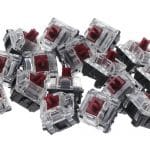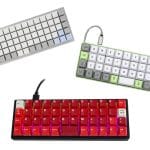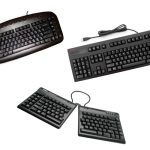
Whether you like your switches tactile or linear, silent or clicky, choosing your switch is one of the most significant custom keyboard choices you will make. One thing that mechanical keyboard users consider when choosing their switch is the spring weight of the switches. But what exactly sets these switches apart from each other? What is Switch Spring Weight, and how does it affect a keyboard switch’s performance?
As the name suggests, spring weight refers to how light or heavy the spring of a certain switch is. These can vary across different keyboard switch models. The weight of the switch spring may affect the actuation force and the overall sound and feel of the switch.
This short guide will discuss how the switch spring weight affects the overall sound, feel, and experience that you will get out of your keyboard build. To do this, let’s first dive into differentiating membrane/rubber dome switch to mechanical key switch in the next section.
Mechanical Switches vs. Membrane/Rubber Dome

Deciding between mechanical and membrane keyboards is a personal decision, much as choosing between your favorite switches. There is nothing inherently wrong with membrane keyboards. But unlike their mechanical counterparts, they lack the tactile feel and clicky feedback that mechanical keyboards provide.
Membrane keyboards are made with rubber beneath the switches, resulting in a quiet, dampened sound and a mushy typing experience. On the other hand, mechanical switches possess a distinct click upon pressing down on the switches. These clicks are present because mechanical switches are spring-loaded and require more force as you press down.
Mechanical key switches also possess a more significant amount of customizability. Different keyboard switches have varying weight actuation requirements available out in the market. Mechanical key switches also tend to be more durable in the long term because of their harder plastic housing built to withstand constant typing.
Though mechanical keyboards may cost a bit more than membrane keyboards, the higher upfront cost will translate better in the long run. They will last longer and keep you more motivated, resulting in better productivity.
Okay, I’m Sold. How Do I Know What Spring Weight to Choose?
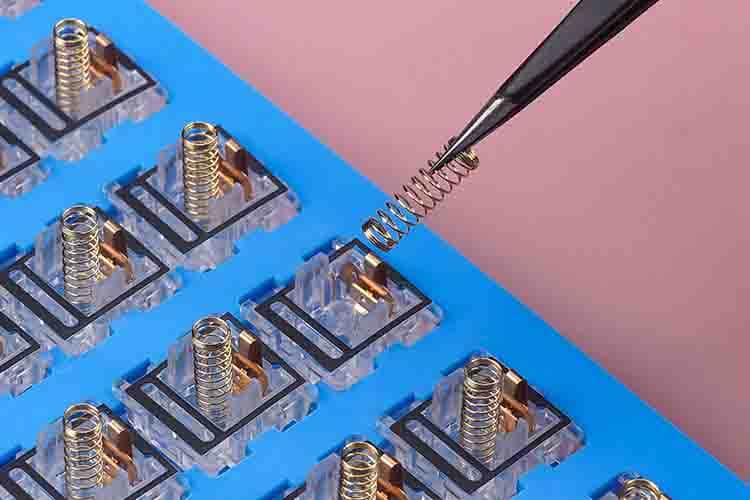
When picking the ideal spring weight for your mechanical keyboard, you should first know the difference between the terms spring weight, actuation, and bottom-out force. Even seasoned keyboard enthusiasts sometimes get the three mixed up. Many users interchange the terms: spring weight, actuation, and bottom-out force depending on the conversation.
The term ‘spring weight’ refers specifically to the weight of the spring within the switch housing. This term should not be confused with ‘actuation force,’ which is defined as the amount of force required to activate a switch upon pressing for it to be recognized by your system.
A heavier spring does not necessarily mean you need a higher actuation force to activate it. The actuation force of a switch is determined by several factors like switch type, spring length, and even the shape of the stem your switches possess.
Some sellers list the two interchangeably when selling switches or prebuilt keyboards. But a good rule of thumb is to double-check the model of your keyboard on the brand website if you are not sure what values the seller has included.
Neither ‘Spring weight’ nor ‘actuation force‘ translate to bottom-out force either. While actuation force is the force required for the key to be recognized, bottom-out force refers to the amount of force needed for a mechanical switch to travel all the way down.
When buying a keyboard or switches, the bottom-out force required usually isn’t a deciding factor. Spring weight and actuation force are the main factors that influence this decision.
To illustrate this further, let us take a look at Holy Pandas. Holy Panda switches possess an actuation force of 67 grams but also happen to possess a spring weight of 67 grams, and this weight would fall under the medium-heavy category of spring weights for switches.
What is the Ideal Spring Weight for Gaming?
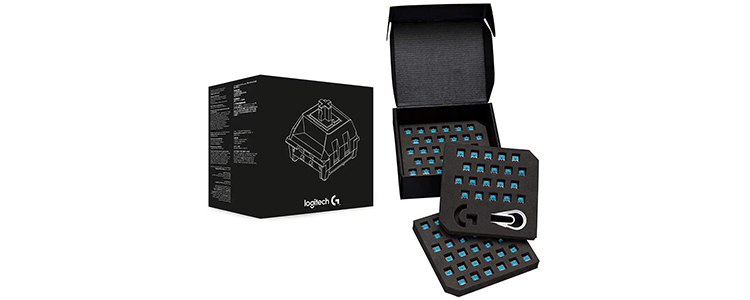
Most gamers, especially professional gaming athletes, prefer lighter switches that range from the 40 to 50 grams spectrum. Lighter spring weights tend to require less actuation force and produce less distracting noise. This is because gaming often requires rapid button presses to execute commands at the touch of a key. Using a switch with a lighter spring weight also reduces fatigue, allowing you to game for longer hours.
What is the Ideal Spring Weight for Typing?
Most typists prefer a daily grinder keyboard with a tactile feel and a heavy spring weight and actuation force. The reason for this is that the added weight cushions the fingers while preventing typos and misclicks from the light brush of a keystroke. Heavy spring weights allow typists to be more conscious of their keyboard input because they hear the feedback of the switch spring as they type.
What is the Ideal Spring Weight for Me?
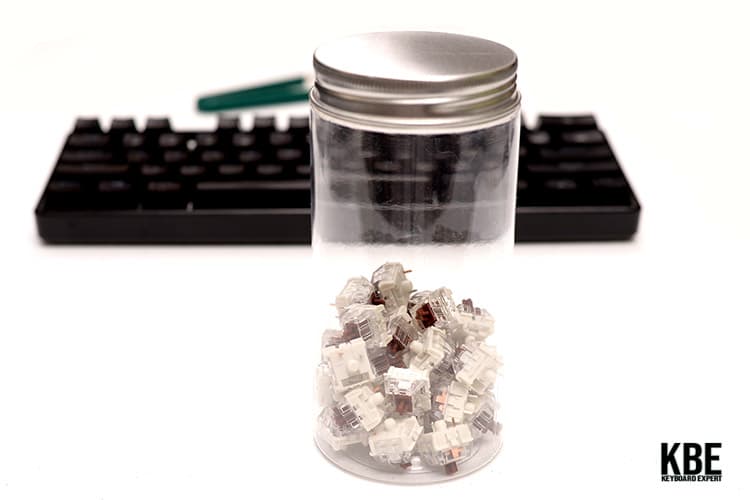
The ideal spring weight for your keyboard depends on your personal preference, and it also depends on the activities you see yourself performing with the keyboard.
For instance, most typists might prefer heavier spring weight switches to avoid misspellings and typos in their documents. In comparison, competitive gamers might prefer lighter spring weight switches because of how much force they need to exert to perform an action in the game.
Typists that game after work hours may choose to stick to their heavy springs as a matter of preference or cost. On the flip side, gamers that perform occasional office work might not mind keeping their light spring switches even if it means they have to keep a lookout for misspelled words and errant characters a little more often than most. Your ideal spring weight is a matter of preference.
Pro Tip: When trying new switches for the first time, ask your seller if they carry switch samplers or purchase a few at a time if possible. Mounting the switches and trying them out is one of the best ways to determine whether or not you will enjoy the experience. To help you out with your decision, here is a brief comparison of the pros and cons of both light and heavy spring weight switches:
Light Spring Weight Switches
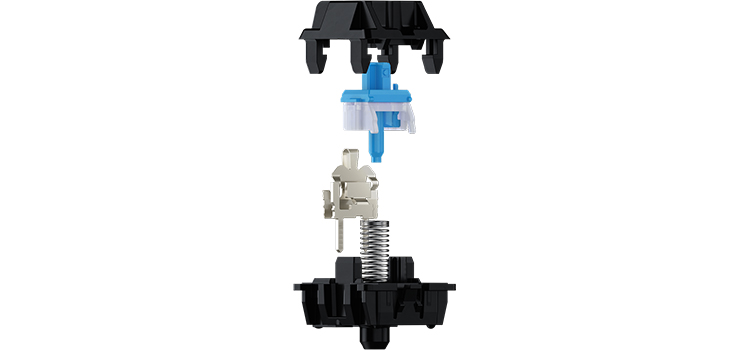
Pros:
- Usually requires less actuation force, meaning a lesser chance of fatigue
- Faster response time for gaming or speed typing
- Subtle or silent typing experience
Cons:
- More prone to errant keystrokes, which can result in mistakes when typing or gaming
- Lack of audible feedback as you type
Heavy Spring Weight Switches
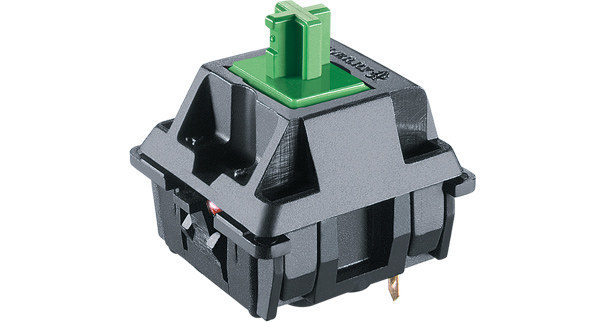
Pros:
- Auditory feedback allows you to be more conscious of your keystrokes
- Lessened chance of committing typos or misclicks when typing or gaming
Cons:
- Heavier actuation force requirement may tire your fingers out faster
- Long gaming or typing sessions may require breaks in between
Do I Need to Change the Springs of My Mechanical Switches?
Swapping out the springs of your mechanical switches is an advanced modification that is certainly possible. However, we would not recommend undertaking such a big modification unless you have prior experience with splitting your switch housing and putting your switches back together after lubing.
We recommend practicing with a few switches at a time so you can get used to the process first. Most prebuilt hot-swappable keyboards and switches come with unlubed springs, so beginners can start with more straightforward modifications such as switching keycaps or replacing a few switches.
Why Should I Lube My Springs?
Practicing how to split and lube your switch springs with a switch sampler is a good exercise before you start pulling switches out of your keyboard to either replace the springs or lube the existing ones. Applying lube to your switch springs creates a smoother feel and a softer sound as you press down. This can also remove the ‘crunchy’ feeling and tinny sound that some springs can make when buying pre-built keyboards and stock switches.
Summary
Part of the joy that comes with being a keyboard enthusiast is trying out what suits you best. Whether typing or gaming, only you can decide what type of switch and spring weight you are happiest with. While both light and heavy switch springs come with their fair share of pros and cons, it is up to you to pick one that fits your lifestyle and keyboard habits best!
We recommend getting a switch with a lightweight spring if you will use your keyboard for gaming, and it will help in the faster and easier pressing of keys. On the other hand, we recommend getting a switch with heavyweight springs; this way, you will avoid typos. Every keypress is felt and heard, making the user more conscious when pressing the keys.
We hope that you enjoyed this short guide on switch spring weights and how they affect your typing experience with your mechanical keyboards. We know all too well the thrill that putting together or modding your own keyboard can provide, so we want to give nothing less than the best in our advice and recommendations. Stay tuned for more news on all things keyboard-related by checking back soon!
